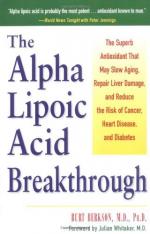|
This section contains 503 words (approx. 2 pages at 300 words per page) |

|
Antioxidants are molecules that prevent or slow down the breakdown of other substances by oxygen. In biology, antioxidants are scavengers of small, reactive molecules known as free radicals and include intracellular enzymes such as superoxide dismutase (SOD), catalase and glutathione peroxidase. Antioxidants can also be extracellular originating as exogenous cofactors such as vitamins. Nutrients functioning as antioxidants include vitamins, for example ascorbic acid (vitamin C), tocopherol (vitamin E) and vitamin A. Trace elements such as the divalent metal ions selenium and zinc also have antioxidant activity as does uric acid, an endogenous product of purine metabolism. Free radicals are molecules with one or more unpaired electrons, which can react rapidly with other molecules in processes of oxidation. They are the normal products of metabolism and are usually controlled by the antioxidants produced by the body or taken in as nutrients. However, stress, aging, and environmental sources such as...
|
This section contains 503 words (approx. 2 pages at 300 words per page) |

|


